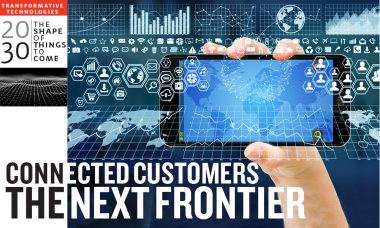
Consumers have more choice now than ever. Why wouldn’t you use readily available data from today’s increasingly connected customer to anticipate their needs, drive innovation, and earn their loyalty? By John Barcus
While successful manufacturers have always had a strong focus on the customer, increased expectations and new technologies are driving a fundamental shift in how manufacturers and customers engage with each other. A shift away from products to services and experiences is inherent throughout our economy, and manufacturers are no exception. That does not mean that manufacturers will quit manufacturing. They will, however, need to be much more aware of their customer’s ultimate needs and how their products are being consumed, and be prepared to understand and both manage and improve the experience across the entire customer lifecycle. Connecting to the customer will be the next frontier of differentiation for companies, providing a win-win situation where the customer is better served at lower total costs for the manufacturer.
To improve the overall customer experience across the customer lifecycle, we must start with knowing all that we can about the customer. For many of us, the advent of e-commerce and the use of our smartphones have made us the ultimate connected customer. Based on our search history, companies understand our wants and desires while providing us offerings and experiences that match those needs seamlessly between devices, and even at the physical locations we visit. The experience will only improve as we continue to share more and more information about ourselves.
Manufacturers have been slower to adopt the same technologies even though it is estimated that more than 61% of B2B transactions are started online and multichannel customers are significantly more profitable than single-channel customers. Most of us have felt the frustration of having to provide the same information over and over again during a single interaction. Customers now expect a totally seamless experience where nothing is entered twice, that you know what products I have, how I am using them, what I am interested in, and even why I am contacting you. Having a constantly updated 360-degree view of your customer can solve this problem and enables a completely personalized experience regardless of how they interact with you or where you are in the customer journey.

“Enhancing the customer experience has become one of the most effective ways of keeping your current customers happy.”
Using AI and Data to Predict Customer Needs
The concept of a 360-degree view of the customer is not new; however, technologies have recently advanced to the point where an understanding of the customer is significantly enhanced by connecting all aspects of the customer journey through marketing, sales, service, and commerce — from the front office to the back office — to deliver a single and unified experience. Using AI to actually predict behavior and solutions is becoming a much more prevalent trend. AI digital assistants that provide 24/7 coverage are realizing the goal of developing an engaging predictive experience. Bajaj Electricals, a provider of consumer products, which include commercial and home lighting products as well as home appliances, uses an AI-based customer service chatbot to let users report broken appliances, schedule installation appointments, and request demos from service technicians to learn how to use new products. This provides a better customer experience and reduces the workload on their customer call center.
Another differentiated benefit enabled by the connected customer is the ability to innovate the right products and services faster. With the increasing use of connected devices and software-driven innovation, it is now possible to know how your customers are using your products, which features they are using the most, and even identify opportunities for enhancements or new products. Knowing exactly what customers want helps to reduce the costs and time to innovate new products along with ensuring the success of those products.
This data that comes from the customer is invaluable input to your innovation process. Sound United’s Denon and Marantz, producers of high-fidelity sound equipment, were able to use data from their new HEOS line of connected speakers to improve the quality of their products and also innovate an entirely new product. Using information available from customers who chose to share their information, they noticed that many named their speakers “bathroom.” Based on this information, they decided to build and offer a product targeted directly for use in the bathroom. They replaced the felt covering with a metal covering and one of their most successful products was born. Trying to get this same information in the traditional manner could have taken years with no guarantee of success.

“Another differentiated benefit enabled by the connected customer is the ability to innovate the right products and services faster.”
As another example, Oracle now predominately offers software products in the cloud as services that provide them real opportunities for continued and rapid innovation. Oracle monitors anonymously which features are and are not being used across the applications and leverages this information as input to the innovation process. With regular quarterly releases, customers can see functionality enhancements in areas where they have the most need, many times without even asking for the enhancements.
Customer-Driven Innovation
Finally, it is important to recognize the benefits to innovation that the combination of the connected customer, software-enabled features, and over-the-air updates has provided. Upgrading our computers with the latest CD, taking our cars in for the latest software update, or having to live with buggy software have all become problems of the past. Over-the-air fixes of smartphones, vehicles, etc., has made all of our lives much easier and more efficient.
The connected customer is now also seriously enhancing the performance and execution of the supply chain. For as long as products have been made and sold, companies have been hyper-focused on reducing costs and improving the efficiencies of the overall supply chain. In fact, with the events of the last few years, the ability for companies to digitize and differentiate their supply chains has, for many, been the difference between success and failure. Connecting the customer is a logical extension of that supply chain. For many of us, that extension is the result of subscriptions, such as the automated replacement of ink for your printer. A simple reminder text or email asking for approval gets you replacement ink along with service recommendations. It is now almost automatic to schedule an oil change or service on your car exactly when it is required — and it is easier than ever. The evolution from having to call for service to advising us when service is required to now predicting and/or automatically scheduling a replenishment or repair with little effort has made or lives much easier. The logical extension to this is offering products as a service. A 3d printing company now only offers their products as a service, making them solely responsible for ensuring uptime and for servicing the products. Constant monitoring allows them to provide the highest level of satisfaction for their customers.
With ever-increasing competition, it is now easier than ever for customers to search out and find other suppliers. Enhancing the customer experience has become one of the most effective ways of keeping your current customers happy and there is no better way of enhancing their experience across the entire customer lifecycle than getting connected to them. M
1 Sath Rao, “Digital Innovation: Scaling for the Fast and Furious Future,” Manufacturing Leadership Journal, April 2020, https://www.manufacturingleadershipcouncil.com/2020/04/10/digital-innovation-scaling-for-the-fast-and-furious-future/
2 Jared Spataro, “2 Years of Digital Transformation in 2 Months,” Microsoft 365 (blog), April 30, 2020, accessed August 10, 2020, https://www.microsoft.com/en-us/microsoft-365/blog/2020/04/30/2-years-digital-transformation-2-months/
3 Sath Rao, “The Case of the Missing Insights,” Manufacturing Leadership Journal, October 2019, https://www.manufacturingleadershipcouncil.com/2019/10/04/the-case-of-the-missing-insights/
4 Knut Alicke, Richa Gupta and Vera Trautwein, “Resetting Supply Chains for the Next Normal,” McKinsey & Company, July 21, 2020, https://www.mckinsey.com/business-functions/operations/our-insights/resetting-supply-chains-for-the-next-normal
5 Joglekar N., Parker G., and Srai J. S., “Winning the Race for Survival: How Advanced Manufacturing Technologies Are Driving Business-Model Innovation,” https://papers.ssrn.com/sol3/papers.cfm?abstract_id=3604242
6 Sath Rao, “Digital Innovation.”
7 Fleming Shi, “Threat Spotlight: Coronavirus-Related Phishing,” Barracuda, March 20, 2020, https://blog.barracuda.com/2020/03/26/threat-spotlight-coronavirus-related-phishing/
8 Edward Barriball, Katy George, Ignacio Marcos and Philipp Radtke, “Jump-Starting Resilient and Reimagined Operations,” McKinsey, May 11, 2020, https://www.mckinsey.com/business-functions/operations/our-insights/jump-starting-resilient-and-reimagined-operations
9 Sath Rao, “The Case of the Missing Insights.”
10 David Uberti, “How BMW Used Pandemic Plant Stoppages to Boost Artificial Intelligence,” The Wall Street Journal, July 28, 2020, https://www.wsj.com/articles/how-bmw-used-pandemic-plant-stoppages-to-boost-artificial-intelligence-11595939400?mod=djemAIPro
11 Rajesh Devnani and Justin Bean, “Health and Safety of Workers,” Hitachi, https://social-innovation.hitachi/en-us/think-ahead/manufacturing/health-and-safety-of-workers/
12 Chris Walton, “3 Ways Starbucks Will Emerge from COVID-19 Stronger Than Before,” Forbes, April 3, 2020, https://www.forbes.com/siteschristopherwalton/2020/04/03/3-ways-starbucks-will-emerge-from-covid-19-stronger-than-before/#1d89d6641844